Text
I’m very pleased to announce that Parakeet Lost is now an award-winner, having received recognition as First Runner-Up in the category of Top Presentation (Undergraduate) at the KSU Symposium of Student Scholars! 🥹 I hope that this, along with the successful display at NCUR, will be another stepping stone in the journey towards getting my work published.


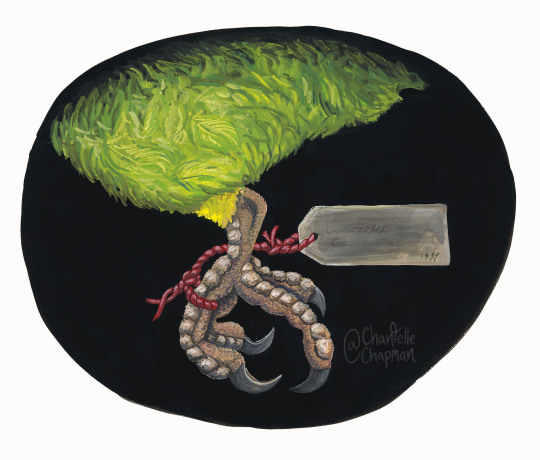
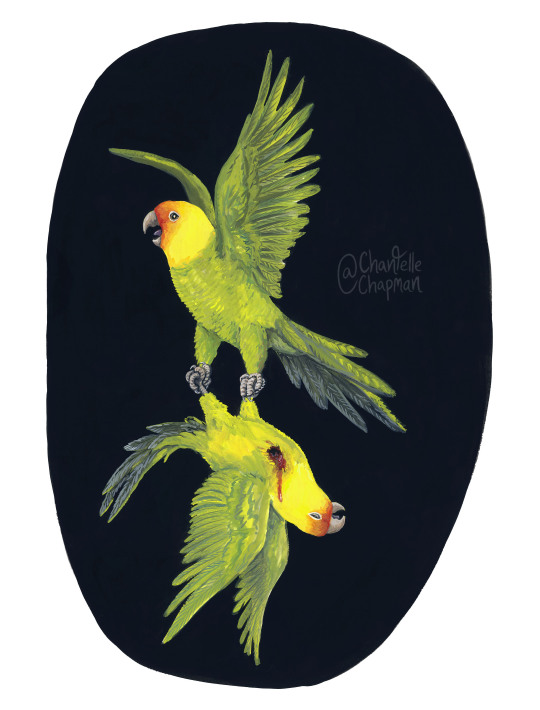
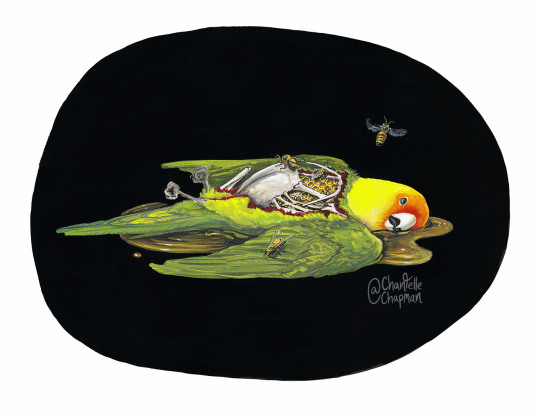

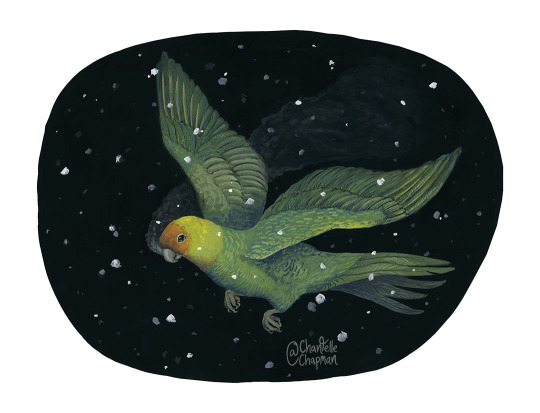
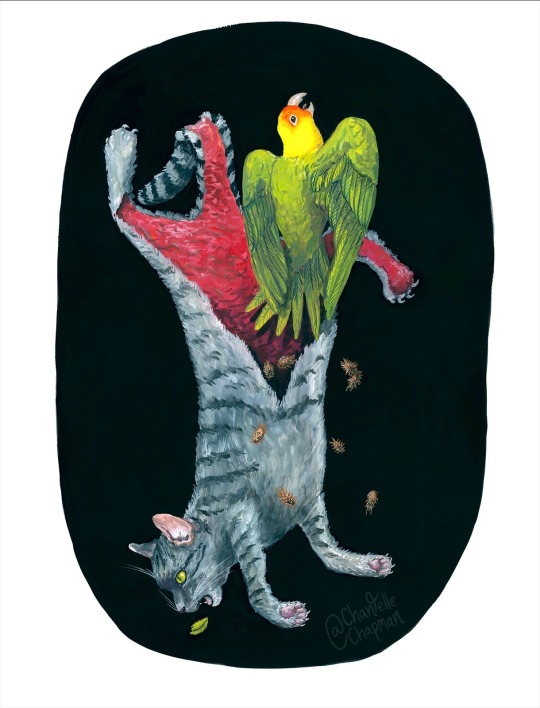

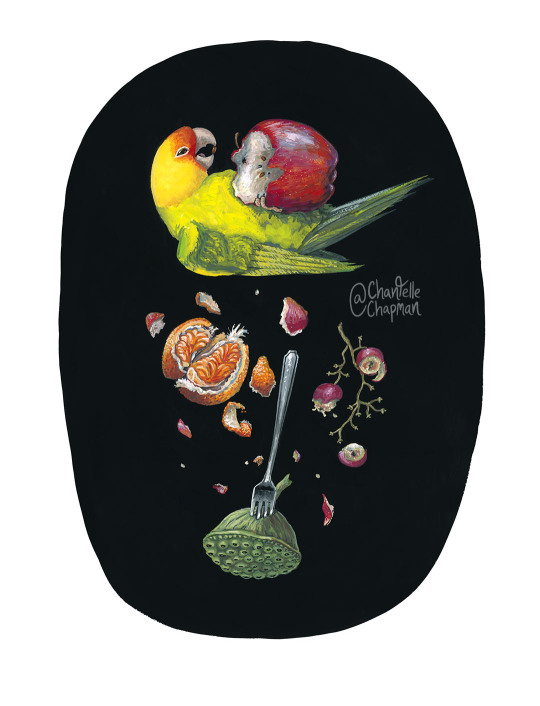
Now that my entire Carolina Parakeet series has been shared, I can finally do a post with ALL of them! So, here is my intended exhibition display layout for the series (I intend for them to be hung 'salon style', in stacked tiers). The title of the full series is Parakeet Lost.
From top left (click the title for more information):
The Etymology of Loss
Memory Knot
Indivisible
The Colonizers
American Tannenbaum
The Warmth of a Living Breath
The Poison of the Cocklebur
We Trim Our Caps with Stolen Feathers
To Each According to His Appetite
All pieces are traditional gouache on paper, and 18x24 inches (with the exception of Memory Knot, which is 13x18").
334 notes
·
View notes
Text









I had some time off from NCUR after my presentation wrapped up, so I made the trip over to the Los Angeles County Natural History Museum, whose exhibits include many wonderful dinosaur and early mammal fossils (including Jordan’s Sea Cow, a relative of Steller’s gigantic variety), full scale taxidermy dioramas, a fantastic Hall of Birds with countless different species, and a wonderful series of original Charles Knight paintings, including his family portrait of the Dodo!
During my visit, I had an appointment with one of the curators of ornithology, to view the collection of specimens not currently on display, and had the opportunity to examine examples of over a dozen different extinct bird species—including my first-ever Great Auk and Huia(!). It was an extremely valuable experience, and I’m looking forward to the artwork that will result.
Thank you so much to LA NHM for its hospitality. It’s a breath-taking, well-curated institution, and I can highly recommend visiting if you have the chance!
29 notes
·
View notes
Text
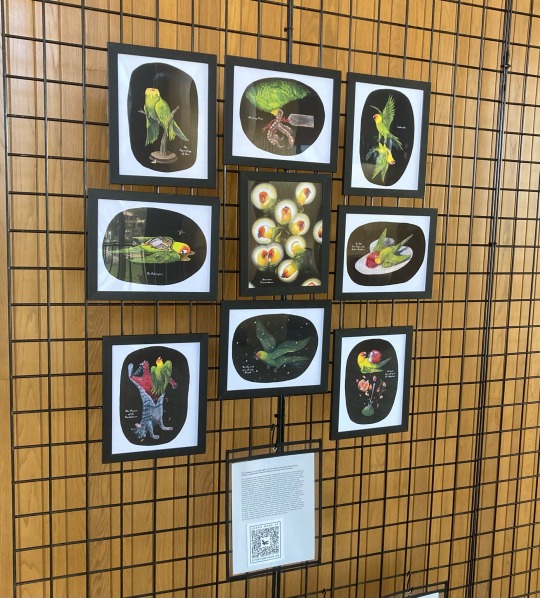
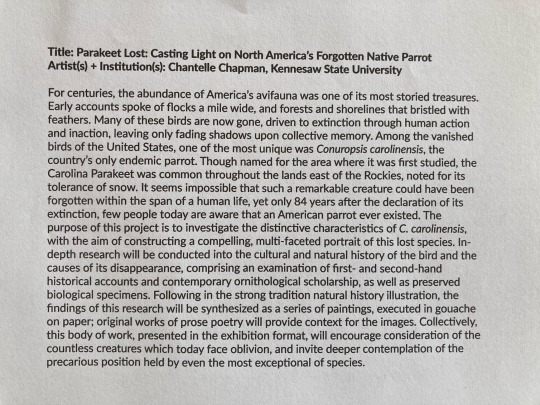

Currently presenting ‘Parakeet Lost’ in the visual arts gallery at the National Conference on Undergraduate Research in Long Beach, California, and getting a wonderful reception! Thank you to everyone who’s dropped by to learn more about Carolina Parakeets and bird extinction!
#carolina parakeet#recently extinct#extinct birds#gotta note that these are prints bc the conference had a size limit for displays!
199 notes
·
View notes
Text


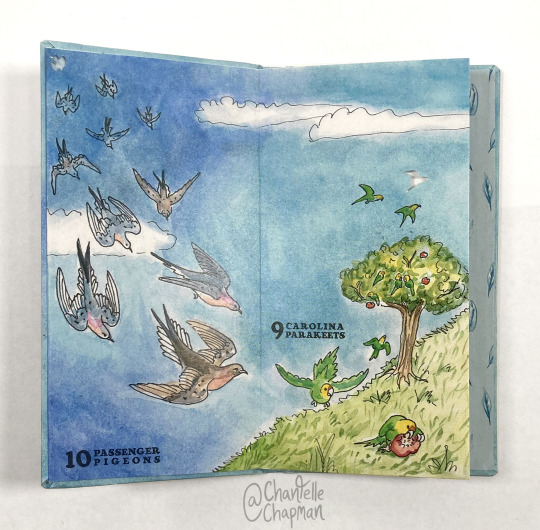
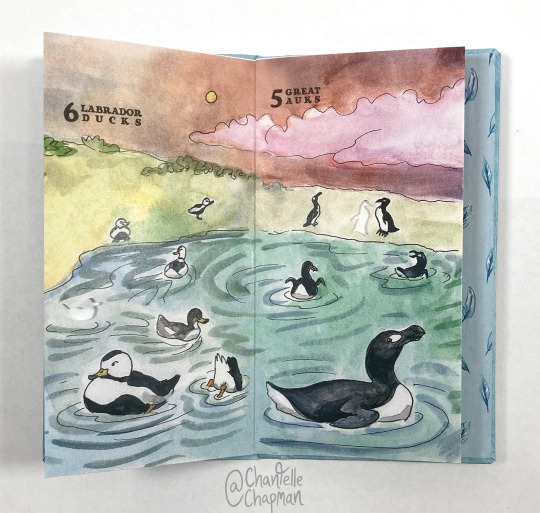


And Then There Were... a miniature counting book that I illustrated and bound by hand. The book is 5 1/2 x 3 inches, and features the extinct Passenger Pigeon, Carolina Parakeet, Heath Hen, Eskimo Curlew, Labrador Duck, Great Auk, Dusky Seaside Sparrow, Bachman's Warbler, Ivory Billed Woodpecker, and Kauai ʻōʻō. Illustrated in traditional pen & ink and watercolor. Like Grasping at Feathers, this book also includes cut-out elements. The concertina-style pages fold out to form one continuous spread. Created as an edition of 5, but I have plans to do another larger run.
#extinct birds#recently extinct#bookarts#passenger pigeon#carolina parakeet#heath hen#eskimo curlew#great auk#dusky seaside sparrow#bachman's warbler#ivory billed woodpecker#kauai o'o#o'o
274 notes
·
View notes
Text



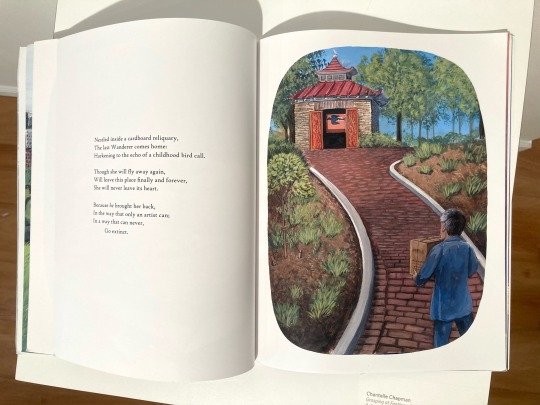

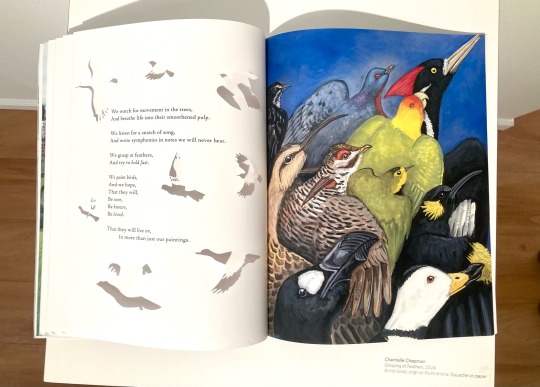

Excerpts from Grasping at Feathers, my reflection on the relationship between extinct and vanishing birds and the artists who have painted them. As featured in my BFA senior capstone exhibition.
The 60-page fully-illustrated book covers three past bird painters and their interaction with a specific lost species: Alexander Wilson and the Ivory Billed Woodpecker, Edward von Siebold Dingle and Bachman’s Warbler, and John Ruthven and the Passenger Pigeon; a fourth ‘chapter’ represents my own perspective as I undertook the research for my Carolina Parakeet series.
All illustrations were created in traditional gouache, and the book also features a number of hand papercuts. Currently, this is an edition of 1, but I hope to make the book more widely available soon!
44 notes
·
View notes
Text

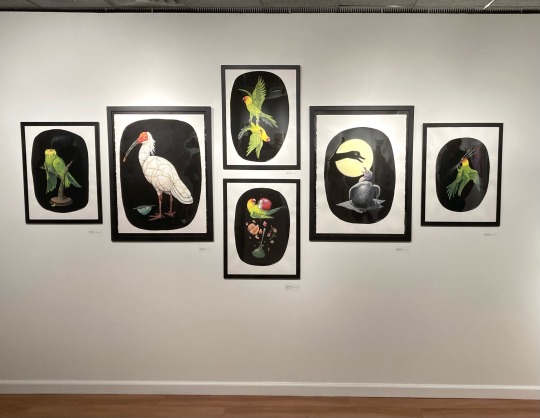
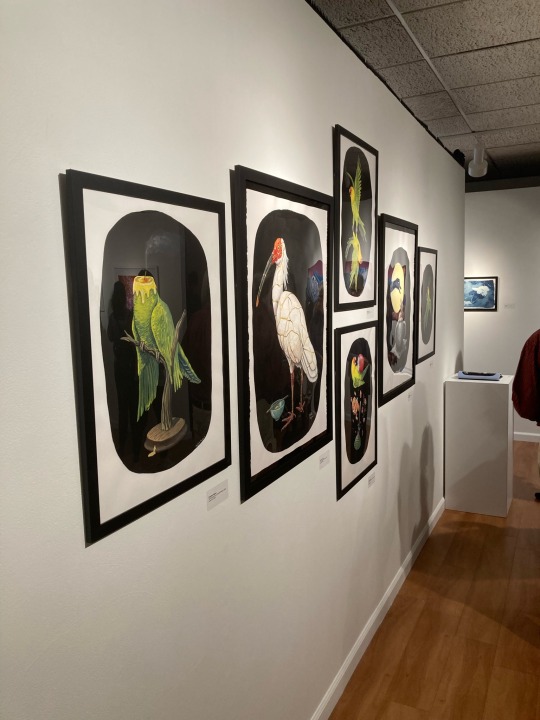

I’m very proud to have presented work from my two latest series, Parakeet Lost and Conservation Pieces, tonight at the opening of my senior exhibition as a BFA painting and illustration student.
And here’s my big announcement: also on display was a full book that I wrote and illustrated over the past six months (remember when I said there was a reason I was posting less often? meet the reason!). Grasping at Feathers explores the relationship between art and lost birds, through the stories of the people who painted them. I’ll be sharing more about this project in the future—stay tuned!
#personal post#carolina parakeet#extinct birds#endangered species#peep that Charley Harper Carolina Parakeet skirt that I sewed special for the occasion 😎#note: updated the series title for Conservation Pi#eces
163 notes
·
View notes
Text









Now that my entire Carolina Parakeet series has been shared, I can finally do a post with ALL of them! So, here is my intended exhibition display layout for the series (I intend for them to be hung 'salon style', in stacked tiers). The title of the full series is Parakeet Lost.
From top left (click the title for more information):
The Etymology of Loss
Memory Knot
Indivisible
The Colonizers
American Tannenbaum
The Warmth of a Living Breath
The Poison of the Cocklebur
We Trim Our Caps with Stolen Feathers
To Each According to His Appetite
All pieces are traditional gouache on paper, and 18x24 inches (with the exception of Memory Knot, which is 13x18").
334 notes
·
View notes
Text

Tie a string around your finger, so you won't forget...
The Carolina Parakeet was declared extinct in 1939.
Up until just the year before, people were still claiming to have sighted the yellow-headed parakeets in the wild—in the impenetrable depths of Georgia's Okefenokee Swamp; along the Santee River basin of South Carolina, where people still search for the Ivory-Billed Woodpecker to this day—but evidence suggested only escaped, feral species of pet birds, tinged by wishful thinking.
The last definitively identified specimen of Conuropsis carolinensis, a male named Incas, had died at the Cincinnati Zoo in 1918. As it happens, his last home was the very same cage in which Martha, the endling Passenger Pigeon, had spent her final years. 2014, the hundredth anniversary of Martha's loss, brought the publication of a number of new books on the topic of the Passenger Pigeon and even a documentary; the centenary of Incas' death, by contrast, warranted only a handful of mentions of our lost native parrot.
Hardly a hundred years later, our parakeet has faded from common memory—like the fading text on the tags that twine around the feet of the study skins that fill museum specimen drawers, where they should have filled the sky, should have filled roosts in hollow trees, should have filled our backyards; should have filled their lungs with air, and our hearts and imaginations and eyes with the sight of their iridescent green feathers.
The title of this painting is Memory Knot. It is gouache on 18 x 13 inch paper, and is the 9th piece in my series on the extinct Carolina Parakeet. It is also the final piece in the series as originally conceived (though inspiration continues to strike, and this is not the last appearance the species will make in my art).
Please, remember that there was a bird called the Carolina Parakeet. Remember what happened to it. Remember that we are the only ones who can keep it from happening again.
949 notes
·
View notes
Note
Your art is so incredible and I am going to buy one of your prints as a gift for myself for my Masters thesis. I am working on the restoration of the American chestnut a functionally extinct tree. As a scientist and an artist I really love your work and appreciate your message ❤️
Thank you SO much! 🥹 The purpose of my art is to share stories that I think are compelling and important, so people can learn about lost species and those that still need our help, and messages like this let me know that I'm doing a good job; it really means a lot to me.
(Also, I'm in the process of adding more pieces to my shop, so keep an eye out for those.)
Speaking of doing a good job: thank you for your important work on the American chestnut! I'm very interested in the restoration projects, and, serendipitously, I am actually in the very early planning stages for some art on that theme. (I'd love to hear more!)
9 notes
·
View notes
Text
Well, after years of dreaming, I have officially booked my trip to Washington D.C.!
My purpose of travel is to finally see Martha, but are there any other extinction-adjacent places I should visit while I’m in town? (Obviously I’m checking out the zoo and the art galleries as well!)
18 notes
·
View notes
Text

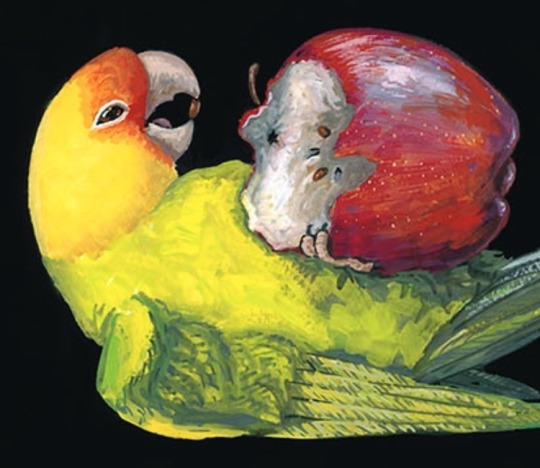


There’s a tale in Greek mythology, of a land of people known as the Lotus Eaters.
Their home was a far-off isle, where they led lives of indulgent indolence, anesthetized by the diet of narcotic fruit that gave them their name. Their existence was blissful, thoughtless, selfish.
Travelers to those shores were often tempted into tasting the lotus themselves—upon which they would lose not only their capacity to care about the wider world, but also their memories of it.
The Carolina Parakeet was a creature doomed by its appetite. The bird preferred to pick seeds from fruit rather than consuming the flesh, and a flock of hungry parakeets, tearing into the hearts of unripe apples on an early summer day, could spell ruin for a farmer. They also had a taste for the corn that was beginning its monopolization of American fields. No amount of helpful bur-clearing could make up for a lost harvest, a lost livelihood.
Our parakeets were beautiful, unique, cheerful, made tame companions, and brightened up the drab, grey days of winter. But they were a threat to human agriculture and economy, and, so, they had to go.
The people who shot and trapped the flocks probably felt like they had no other option. And maybe they didn’t. Maybe you or I would have done the same—willing to sacrifice a few ravenous birds to make sure our families wouldn’t be the ones to starve instead. (What are the concerns of a different species, when your own children cry out in hunger—whether man or parakeet?)
But to remember that a bird called the Carolina Parakeet existed—to remember what we did to it, what we’ve done to hundreds of other lost creatures, and those that continue to vanish every day—is a decision that is fully in our own hands. Yet, less than a century after its extinction, this remarkable bird, once known across the continent, has already slipped from common, collective memory.
To forget is a choice that no one should stomach.
The title of this painting is ‘To Each According to His Appetite’. It is gouache on 18x24” paper, and is #8 in my series focusing on the extinct Carolina Parakeet.
140 notes
·
View notes
Text




There’s a tale in Greek mythology, of a land of people known as the Lotus Eaters.
Their home was a far-off isle, where they led lives of indulgent indolence, anesthetized by the diet of narcotic fruit that gave them their name. Their existence was blissful, thoughtless, selfish.
Travelers to those shores were often tempted into tasting the lotus themselves—upon which they would lose not only their capacity to care about the wider world, but also their memories of it.
The Carolina Parakeet was a creature doomed by its appetite. The bird preferred to pick seeds from fruit rather than consuming the flesh, and a flock of hungry parakeets, tearing into the hearts of unripe apples on an early summer day, could spell ruin for a farmer. They also had a taste for the corn that was beginning its monopolization of American fields. No amount of helpful bur-clearing could make up for a lost harvest, a lost livelihood.
Our parakeets were beautiful, unique, cheerful, made tame companions, and brightened up the drab, grey days of winter. But they were a threat to human agriculture and economy, and, so, they had to go.
The people who shot and trapped the flocks probably felt like they had no other option. And maybe they didn’t. Maybe you or I would have done the same—willing to sacrifice a few ravenous birds to make sure our families wouldn’t be the ones to starve instead. (What are the concerns of a different species, when your own children cry out in hunger—whether man or parakeet?)
But to remember that a bird called the Carolina Parakeet existed—to remember what we did to it, what we’ve done to hundreds of other lost creatures, and those that continue to vanish every day—is a decision that is fully in our own hands. Yet, less than a century after its extinction, this remarkable bird, once known across the continent, has already slipped from common, collective memory.
To forget is a choice that no one should stomach.
The title of this painting is ‘To Each According to His Appetite’. It is gouache on 18x24” paper, and is #8 in my series focusing on the extinct Carolina Parakeet.
#recently extinct#extinct birds#carolina parakeet#extinct animals#extinction#note: just so everyone knows I AM aware that the lotus in the story isn’t THAT kind of lotus#sometimes sacrifices must be made for the sake of legible symbolism#don’t @ me okay :P
140 notes
·
View notes
Text
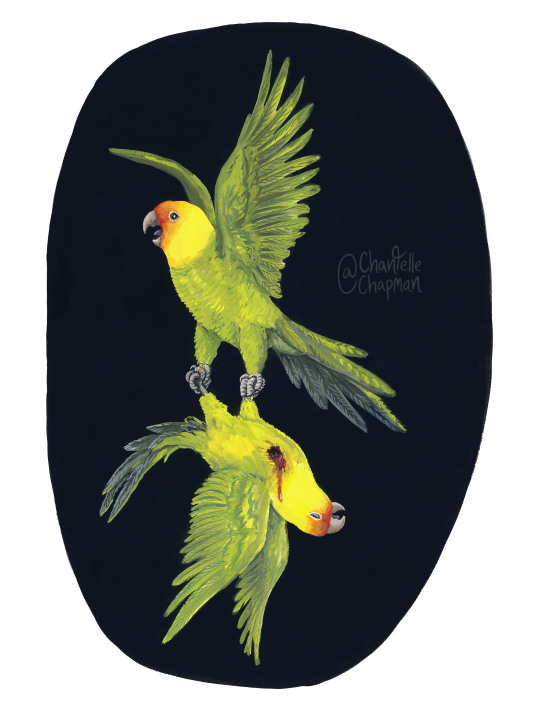
There are many 'reasons' why a particular species may be singled out for deliberate extermination: fear; greed; contempt; superstition; sheer convenience; sheer ignorance. The Carolina Parakeet had a reputation for ransacking fruit trees and destroying harvests.
Just as significant, though are the reasons why an extermination is accomplished: puny wings, or small litter sizes; rigid habitat needs, or insular naivety.
Sometimes, a great weakness can lay hidden within one's dearest strength.
Even taking into account the high level of interpersonal importance that might be expected of a parrot species, the Carolina Parakeet was intensely social.
Lighting together and coating tree branches in leaves of shimmering blue-green, they kept up a near-constant racket of nattering squawks, audible from a great distance. At the height of their prosperity, the small birds travelled in flocks of hundreds, even thousands.
Even more unusually, they were noted to have nested communally: though each bird would lay only two eggs per clutch, there were records of great numbers of nestlings being discovered in a single tree-hollow nest, with care provided by many parents, who clung by beak and claw to the outside bark when there wasn't sufficient space inside.
They were vulnerable, but there was safety in numbers; there was safety in the ability to call for backup, confident that an answer would come.
If one parakeet screeched in pain or fear, the rest of a flock would be quick to rally around their comrade—drawn in inexorably, to swoop and shriek in the face of danger, until the threat (perhaps a hawk, or an egg-thieving raccoon) was forced to concede the point and turned tail.
Most animals, predator and prey alike, will flee from a loud, relentless barrage.
Flocks of nearly every bird species will fly away, flushing desperately towards safety, at the first bang of a shotgun blast.
The Carolina Parakeet, fired upon by overwrought orchard owners, circled its fallen friends until there were none left to cry out.
The title of this painting is ’Indivisible’. It is gouache on 18x24" paper, and is #7 in my series about America's extinct Carolina Parakeet.
314 notes
·
View notes
Text
In case you’re wondering where I’ve been lately, I’m working on my graduation show for my BFA. It’s endangered/extinct bird themed. And I’m going to share it all here eventually. Basically, watch this space! 🪶
27 notes
·
View notes
Note
Thank you for helping me grieve.
This message touched me very deeply. Thank you. I’m so grateful to have the chance to talk about these animals, and to know that they are so, so loved.
25 notes
·
View notes
Note
saw the great auk and faded tasmanian tiger taxidermy in london NHM yesterday. i dont have anything to say that hasnt been said before, just kinda :(. even so, i feel lucky to be able to see them so long after their demise
What a precious experience. I’m glad that you got to see them, too. 🥺 Thank you for sharing!
15 notes
·
View notes
Note
Your blog is amazing and heartbreaking. Thank you for doing this.
Thank you! It means a lot to me that people appreciate it, and that some of these stories are getting a bit more exposure. Every time I see someone tag a post with, "I never knew about this," it makes my heart hurt (in a good way).
6 notes
·
View notes